Captain Phillip Allen Ducat
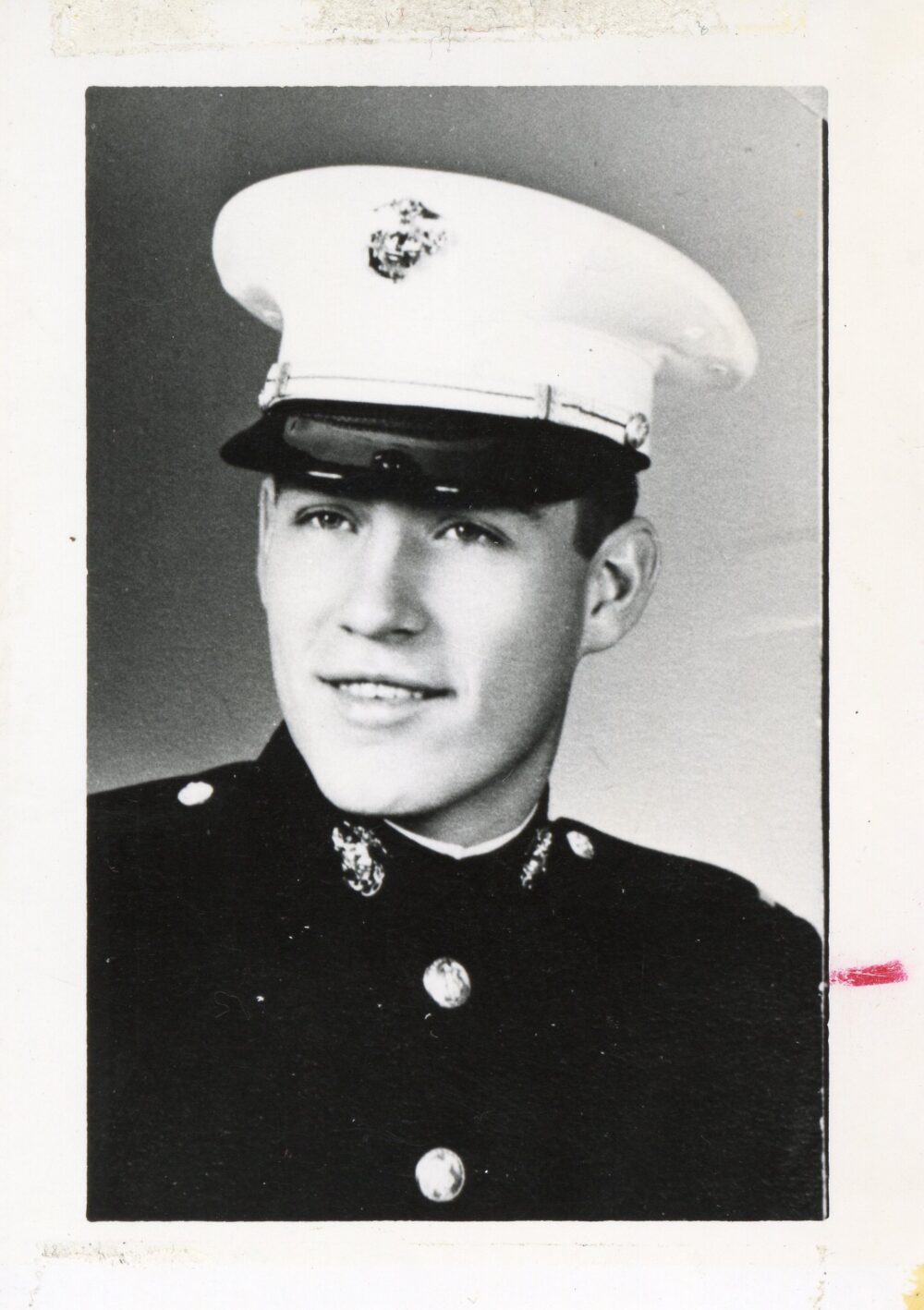
- Unit: 1st Marine Aircraft Wing, Marine Air Group 16, Marine Medium Helicopter Squadron 164 and Marine Medium Helicopter Squadron 161
- Service Number: 86222
- Date of Birth: September 4, 1939
- Date of Death: September 25, 1966
- Hometown: Fort Wayne, Indiana
- Place of Death: Quang Tri Province, South Vietnam
- Award(s): Distinguished Flying Cross, Purple Heart, Air Medal, National Defense Service Medal, Vietnam Service Medal, Vietnam Gallantry Cross Unit Citation, Vietnam Civil Actions Unit Citation, Republic of Vietnam Campaign Medal
- Cemetery: Courts of the Missing, Court A, Honolulu Memorial. National Memorial Cemetery of the Pacific, Honolulu, Hawaiʻi
Columbia City High School (Columbia City, Indiana)
2024/2025
Early Life
Phillip Allen Ducat was born in Kentucky on September 4, 1939. Not long after, he was adopted by Claud (who often went by his middle name, Allen) and Florence Ducat and brought to live in Fort Wayne, Indiana. Claud worked different jobs to support his family, including working at the Wayne Knitting Mills and as a carpenter making cabinets. Florence worked in the home.
Two years after Phillip was adopted, Claud and Florence also adopted a daughter, Mary Ann, from Kentucky. They lived in a building complex on Spy Run Avenue, just down the road from where the original Old Fort Wayne originally stood in 1815. They attended a local Catholic Church.
Ducat attended St. Mary’s School, a Catholic grade school where he was a member of the school safety patrol. Afterward, he entered North Side High School, where he was an active participant in many extracurricular activities. Ducat was a standout on the Redskins varsity football team getting named to the All-City team as a guard. He was a member of the 1956 state champion track team, the vice president of the student council, a member of the Helicon Literary Club, and a member of the cheer block. Ducat was also often seen driving in his 1949 Mercury.
Ducat graduated from North Side High School in 1957 and married Susan Madge Renforth, his high school sweetheart, who started high school at Central Catholic in Fort Wayne, but transferred to North Side in 1957. They married on September 28, 1958, at the Wayne Street Methodist Episcopal Church in Fort Wayne. He then enrolled at Wabash College, majoring in zoology.
Ducat, nicknamed Duke, was active on campus, participating in intramural football, track, and basketball for his fraternity, Delta Tau Delta. He was also a member of the Sphinx Club, a group dedicated to fostering campus unity and spirit throughout the Wabash community by sponsoring and promoting various campus events. He and Susan lived in a small upstairs apartment close to campus in Crawfordsville, Indiana. He would often go hunting on the weekends to support his little family. Upon graduation in 1962, shocking his family, he enlisted in the United States Marine Corps.
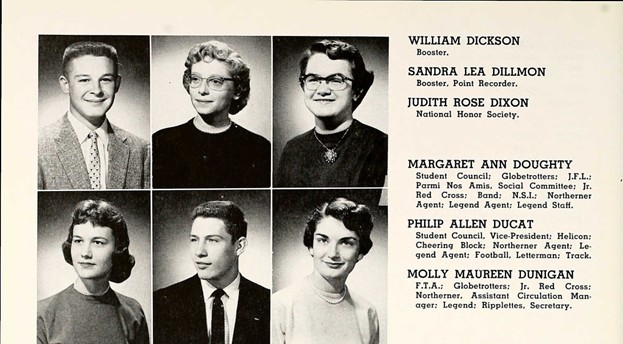
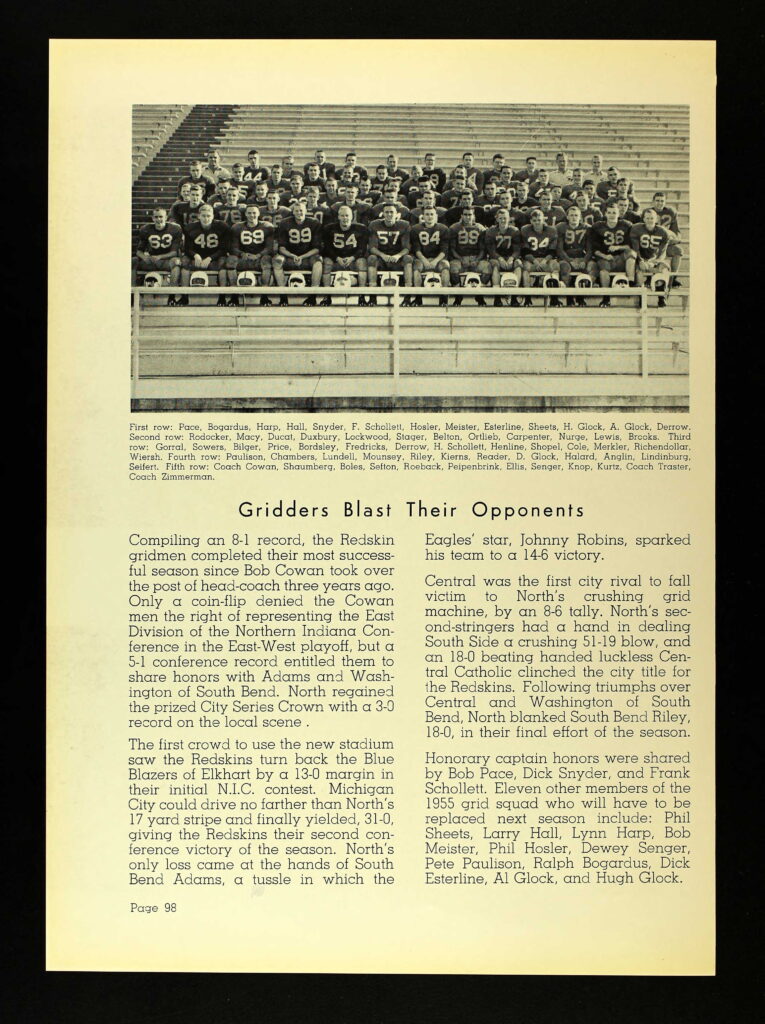

Homefront
After the Battle of Fallen Timbers in 1793, General Anthony Wayne established a new fort in the Miami settlement of Kekionga in modern-day Indiana. Though the fort did not last, the name did, and the settlement of Fort Wayne continued to grow thanks to the trade routes that passed through the area. By 1840, Fort Wayne, Indiana, officially became a city.
The Pennsylvania Railroad expanded into the city in the late 1800s, bringing both industry and an influx of German and Irish immigrants to the city. The Jenny Electric Company was established in Fort Wayne to provide electric lights to railroads and was then taken over by General Electric (GE) in 1898, converting the plant to produce electric engines.
By the 1940s, GE employed over 40% of all of Fort Wayne’s employees. In the 1930s, three more major companies made their way to Fort Wayne: the Tokheim Company (oil tanks and pumps), Magnavox (weapons components and electronics), and International Harvester (torpedoes, ammunition shells, engines). All three of the industries skyrocketed as they helped to provide the industrial goods needed by the U.S. armed forces during World War II.
The city’s population continued to boom even after the war, as workers moved to the city for work, leading to the development of more shopping centers like Quimby Village and Southgate Shopping Center, and the area’s first major arena, the Memorial Coliseum. The 1950s and 1960s also brought to Fort Wayne a change seen all over the nation as people began leaving the city to move into the newly developed suburbs. Industry also continued to boom with Fort Wayne’s International Harvester plant producing over 250 heavy-duty trucks a day, leading to the nickname Truck Town.
Also in the 1960s, Fort Wayne’s manufacturing industries played a major role in supplying the military for the Vietnam War. GE produced radar systems, avionics, and electrical components for aircraft and military vehicles. These technologies were critical for reconnaissance, navigation, and combat operations in Vietnam.
International Harvester produced heavy machinery and military vehicles, including cargo trucks and troop transports. They also produced diesel engines that were used for generators in Vietnam. Magnavox developed radios, sonobuoys, and a data management system for the field.
Though a high percentage of Fort Wayne residents worked at one of these manufacturing plants and generally supported the Vietnam War, there were anti-war protests that targeted manufacturing. In November 1969, protesters gathered outside the Allen County Federal Building for a candlelight protest of the war, and posters targeting GE were plastered around the city stating that “war profit is their most important product.”


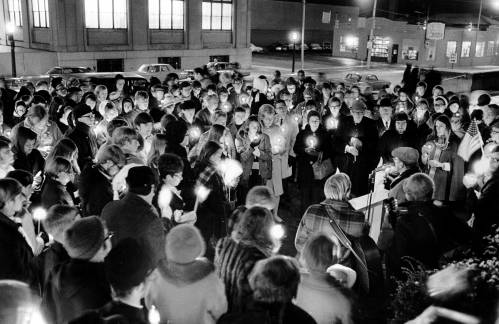
Military Experience
Ducat’s military training began in Pensacola, Florida, in 1962 at the Marine Aviation Detachment. He trained there until 1964 when he transferred to a base in Santa Ana, California, that was originally a Naval Airbase. Recommissioned in 1951 as the Marine Corps Air Facility Santa Ana, Ducat was assigned to the Marine Medium Helicopter Squadron-164. Though he switched squadrons a few times between 1964 and 1966, Ducat remained stationed at Santa Ana until 1966, when he was deployed to Vietnam as a member of Marine Medium Helicopter Squadron-164 (HMM-164).
Ducat flew both a Sikorsky UH-34D and a CH-46 helicopter. The US-34 D was known as the “Seahorse,” a medium-lift helicopter that became the workhorse of the Marines in Vietnam. The CH-46, known as the “Sea Knight,” was newer and larger, eventually replacing the Seahorse. Regardless of which helicopter was in use, the pilots transported troops into and out of combat, dropped off supplies, food, and ammunition, and coordinated medical evacuations of wounded servicemembers.
HMM-164 loaded the USS Princeton for deployment in February 1966. On March 4, the helicopter squadron transferred over to the deck of the aircraft carrier USS Valley Forge. The group transferred from the carrier to the Marble Mountain Army Airfield on March 8, and almost immediately went into battle. Reports show that the HMM-164 flew over 2,000 sorties in its first 35 days in Vietnam.
In June 1966, HMM-164 was sent to assist the US Army’s 101st Airborne Division that had been surrounded at Dak To by the North Vietnamese. Operation Hawthorne’s mission called for the men of the 101st Airborne Division to support the Army of the Republic of Vietnam (ARVN) stationed at Dak To. The ARVN found themselves surrounded by the North Vietnamese forces by June 6. On June 11, the 101st Airborne Division was engaged in fighting so fierce that the commander called for a napalm attack on his own position, hoping to find a way out of the encirclement.
Four helicopters were sent in to assist with medical evacuations, including one piloted by Ducat. On that day, over 63 Marines were airlifted out of Dak To “under extremely hazardous conditions.” Ducat was recommended for the Distinguished Flying Cross for his efforts during this mission.
In July, Operation Hastings began to counter the North Vietnamese Army south of the demilitarized zone (DMZ). The Marines were called in to conduct reconnaissance missions and to block further movement into South Vietnam. HMM-164 was used extensively during this time to fly Marines into and out of the recon zone, often taking small hits from enemy fire. July 15 marked an increase in Marine activity with 27 helicopters from Ducat’s division transporting 550 troops into the region for the mission. Over the next few weeks, HMM-164 moved Marines into and out of the area, conducted medical evacuations, and supplied the forces.
Sometime between July and September, Ducat transferred to HMM-161 to assist with Operation Hastings. HMM-161 was short of UH-34D pilots. This squadron was stationed in the province of Da Nang at the Phu Bai base, which was the northernmost base in South Vietnam.
Beginning in August, the 1st Marine Aircraft Wing was ordered to assist with Operation Prairie, a search-and-destroy mission throughout the Quang Tri province, just south of the DMZ. The goal was to seek out any bases or strongholds set up by the North Vietnamese Army (NVA) and destroy them. The operation was carried out by Marines on the ground, supported by the Marine helicopter units above, similar to Operation Hastings.
Throughout August and September, multiple battles took place along the DMZ, a mountainous region often covered in dense jungle. This strategy by the North Vietnamese Army was to lure the Americans away from major cities into territory much more difficult to maneuver. Ducat’s helicopter unit would drop in Marine ground troops to set up reconnaissance posts throughout the region to watch for NVA troops trying to infiltrate the area. The ground troops would then call in the positions for nearby artillery to fire upon. Ducat and his fellow Marine helicopter pilots would then fly back into the jungles to pick up the ground troops, often amid a firefight.
Operation Prairie lasted for six months across the ridges and valleys close to the DMZ in South Vietnam. Though it was considered a success for the Americans, it came at a high cost, with over 200 Marines killed in action.
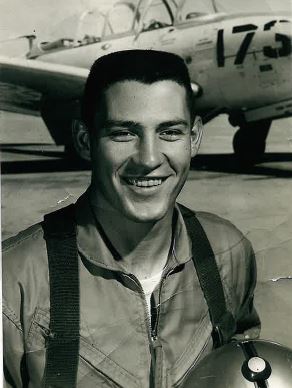
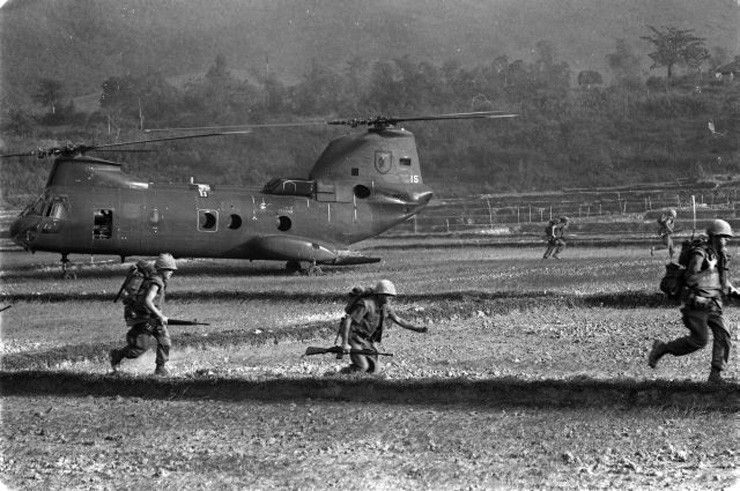
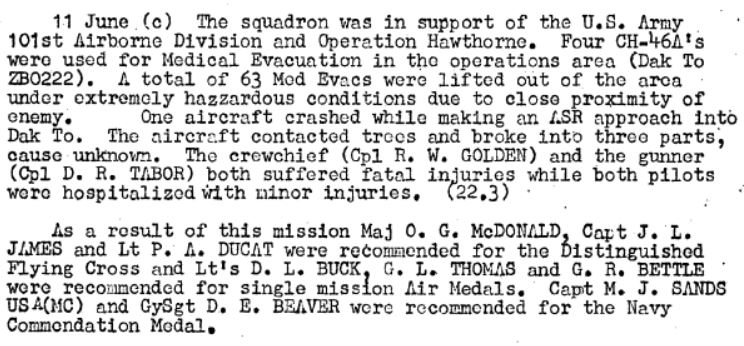
Commemoration
On September 25, 1966, Ducat and four crew members of his helicopter were sent into the Quang Tri Province on a “dustoff” mission, a medical evacuation. He was escorted by two “gunships,” smaller, more maneuverable, and heavily armed helicopters. Just past 7:00 p.m., just after sunset, Ducat’s chopper descended to the landing zone to retrieve a Marine who had been wounded by a mine. The crew recovered the injured Marine and secured him in the helicopter. Ducat took his helicopter airborne again to join the other helicopters waiting in the air for him.
As they went into motion again to retrieve another wounded Marine, Ducat announced over the radio that his chopper would move to the front of the group. His helicopter was then struck in the pilot’s compartment by an artillery shell from Camp Carroll, a U.S. Marine and Army of the Republic of Vietnam artillery base located in the Quang Tri Province. The helicopter exploded and crashed. The other Marine helicopters could only watch as their comrades were killed by friendly fire. Though some remains were later recovered and identified, Ducat’s remains were never found. Some of his squadron later returned to the site of the helicopter crash and found a boot they believed was Ducat’s because of the way he laced them with paracord.
Ducat was posthumously promoted from first lieutenant to captain. He was also posthumously awarded the Distinguished Flying Cross for heroic actions on June 11, 1966, “for his outstanding performance of duty while evacuating forty-seven US Army Troops and the bodies of seven who had been killed in action.” While in Vietnam, Ducat logged over 1,300 hours of airtime.
A memorial service was held for Captain Ducat in Fort Wayne at Most Precious Blood Catholic Church, and a headstone was placed in the Catholic cemetery there. Ducat is also memorialized on the Honolulu Memorial at the National Memorial Cemetery of the Pacific in Honolulu, Hawaiʻi, and on panel 11E, line 013 of the Vietnam Veterans Memorial in Washington, D.C.
Captain Phillip Ducat left behind his wife, Susan, his parents, Claud and Florence, and his sister, MaryAnn. He was a servant of his country, and we honor his sacrifice. Always faithful.


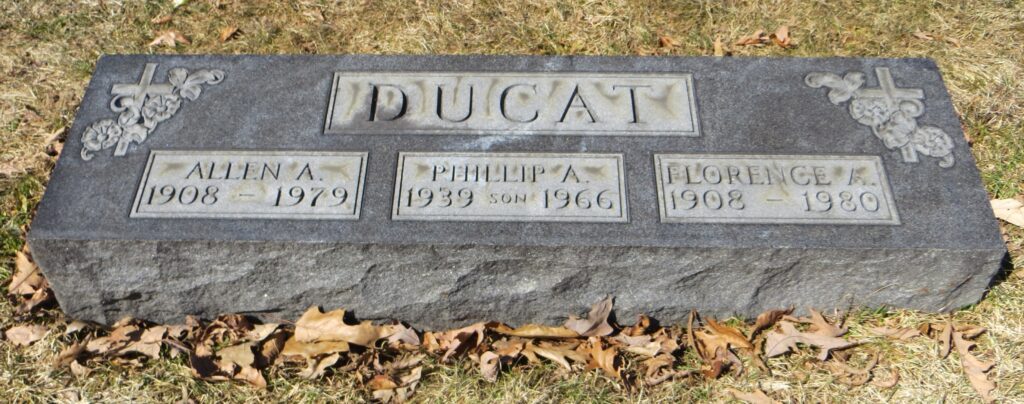
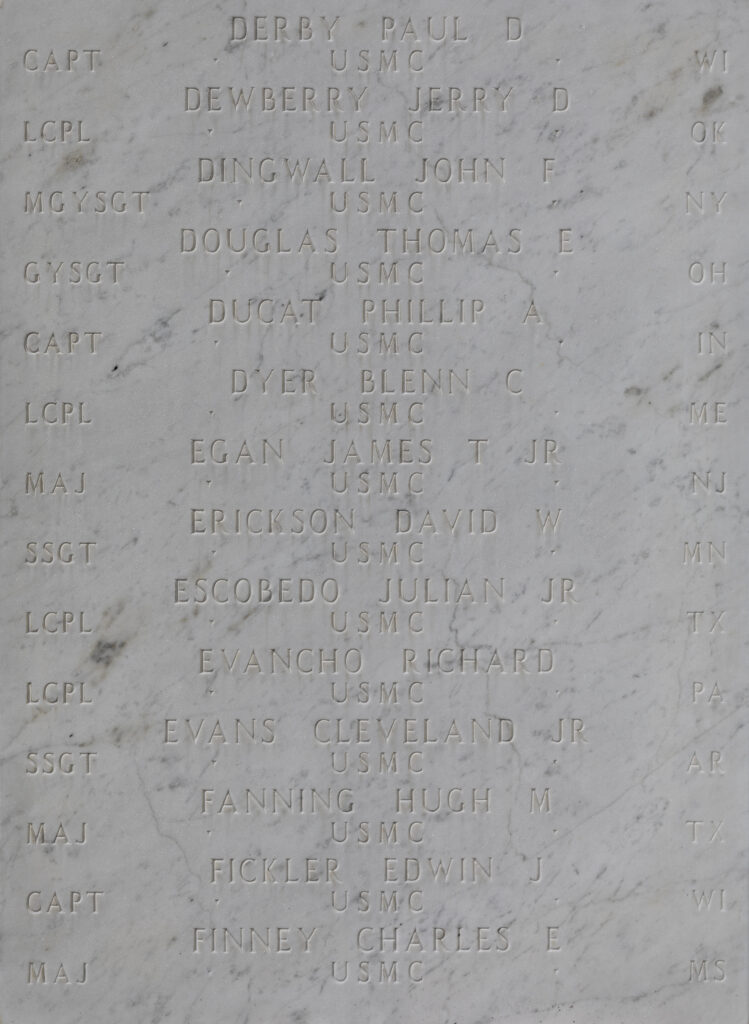
Bibliography
Primary Sources
CH-46 Sea Knight Operations in South Vietnam. Photograph. Naval History and Heritage Command. Accessed March 27, 2025. https://www.history.navy.mil/content/history/museums/nnam/explore/collections/aircraft/c/ch-46a-sea-knight/ch-46-sea-knight-operations-in-south-vietnam.html.
Command Chronology [HMM-161]. U.S. Marine Corps History Division. Vietnam War Documents Collection, Vietnam Center and Sam Johnson Vietnam Archive, Texas Tech University (1201079199). https://www.vietnam.ttu.edu/virtualarchive/items.php?item=1201079199.
Command Chronology [HMM-161]. U.S. Marine Corps History Division. Vietnam War Documents Collection, Vietnam Center and Sam Johnson Vietnam Archive, Texas Tech University (1201079200). https://www.vietnam.ttu.edu/virtualarchive/items.php?item=1201079200.
Command Chronology [HMM-164]. U.S. Marine Corps History Division. Vietnam War Documents Collection, Vietnam Center and Sam Johnson Vietnam Archive, Texas Tech University (1201081065). https://www.vietnam.ttu.edu/virtualarchive/items.php?item=1201081065.
Command Chronology [HMM-164]. U.S. Marine Corps History Division. Vietnam War Documents Collection, Vietnam Center and Sam Johnson Vietnam Archive, Texas Tech University (1201081066). https://www.vietnam.ttu.edu/virtualarchive/items.php?item=1201081066.
Command Chronology [HMM-164]. U.S. Marine Corps History Division. Vietnam War Documents Collection, Vietnam Center and Sam Johnson Vietnam Archive, Texas Tech University (1201081067). https://www.vietnam.ttu.edu/virtualarchive/items.php?item=1201081067.
A Day in the Life of a Helicopter Pilot. Film. 1967. U.S. Army. Accessed February 28, 2025. https://commons.m.wikimedia.org/wiki/File:CH-47_Chinook_in_Vietnam_War_-_A_Day_in_the_Life_of_a_Helicopter_Pilot_(1967),_U.S._Army.webm.
Ducat, Susan. Personal interview with the author. April 3, 2025.
“Fort Wayne Plant of International Harvester Co. Nearing Completion.” Fort Wayne Journal-Gazette [Fort Wayne, IN], July 1, 1923. Newspapers.com (157797638).
“General Electric XT700-GE-700 Turboshaft Engine.” Smithsonian’s National Air and Space Museum. Accessed January 17, 2025. https://airandspace.si.edu/collection-objects/general-electric-xt700-ge-700-turboshaft-engine/nasm_A19860224000.
Indiana. Allen County. 1900 U.S. Census. Digital images. https://ancestryclasroom.com.
Indiana. Allen County. 1910 U.S. Census. Digital images. https://ancestryclasroom.com.
Indiana. Allen County. 1920 U.S. Census. Digital images. https://ancestryclasroom.com.
Indiana. Allen County. 1930 U.S. Census. Digital images. https://ancestryclasroom.com.
Indiana. Allen County. 1940 U.S. Census. Digital images. https://ancestryclasroom.com.
Indiana. Allen County. 1950 U.S. Census. Digital images. https://ancestryclasroom.com.
Iowa Veteran Describes Experiences as a Helicopter Pilot. Video [3:13]. Iowa PBS. Accessed February 28, 2025. https://www.iowapbs.org/iowapathways/artifact/1525/iowa-veteran-describes-experiences-helicopter-pilot-vietnam-war.
Legend, North Side High School Yearbook. Allen County Public Schools, 1957. https://ancestryclassroom.com.
“Memorial Mass for Viet Victim.” October 3, 1966, Fort Wayne Journal-Gazette [Fort Wayne, IN], October 3, 1966. Allen County Genealogical Society of Indiana. https://www.acgsi.org/military/vietdead/ducat.philip.jpg.
Men Using International 270 Pay Scraper in Vietnam. Photograph. International Harvester Company Corporate Archives, Wisconsin Historical Society (86730). https://wisconsinhistory.org/Records/Image/IM86730.
Perfection Brand Shipping Crate. c.1920s. The History Center. https://www.fwhistorycenter.org/virtual-exhibits/vex18/2EFC49B6-BF63-4883-B51C-291294562868.htm
Phillip Allen Ducat Collection. Veterans History Project, Library of Congress (AFC/2001/001/68873). https://www.loc.gov/item/afc2001001.68873/.
Phillip Allen Ducat. U.S. Vietnam War Military Casualties, 1956-1998. https://www.ancestryclassroom.com.
Seahorse: Marines board Sikorsky UH-34 Seahorses that will transport them in August 1966 to landing zones during Operation Colorado in northern South Vietnam. Photograph. August 1966. Historynet. Accessed February 28, 2025. https://www.historynet.com/helos/seahorse/.
Vietnam helicopter pilots describe the war from the cockpit. Video [9:49]. Military Times. April 18, 2018. Accessed February 28, 2025. https://www.youtube.com/watch?v=6toXHd0xGdg.
Secondary Sources
“Capt Phillip Allen Ducat.” Defense Personnel POW/MIA Accounting Agency. Accessed November 18, 2024. https://www.dpaa.mil/portals/85/VietnamAccounting/pmsea_una_MARINE%20CORPS_20200605.pdf.
“Capt. Phillip Allen ‘Phil’ Ducat.” Find a Grave. Updated April 16, 2021. Accessed November 18, 2024. https://www.findagrave.com/memorial/88595039/phillip_allen-ducat.
“Ducat, Phillip Allen, Capt.” Together We Served. Accessed February 25, 2025. https://marines.togetherweserved.com/usmc/servlet/tws.webapp.WebApp?cmd=ShadowBoxProfile&type=Person&ID=45737.
“Fort Wayne History.” Fort Wayne Community Development. Accessed January 18, 2025. https://www.fwcommunitydevelopment.org/planning/13-about-us/27-fort-wayne-history.
“Fort Wayne Memories: The 60s.” PBS Fort Wayne. Accessed January 18, 2025. https://www.pbs.org/show/fort-wayne-memories-60s/.
Haas Zuber, Connie. “Change in the 1960s.” Fort Wayne News-Sentinel. Accessed April 17, 2025. http://egen.fortwayne.com/ns/projects/history/2000/1960/change1.php.
“Heroes in Hueys: The Pilots and Crews of the Vietnam War.” University of Nebraska. Accessed February 25, 2025. https://unodigitalhumanitiesprojects.omeka.net/exhibits/show/heroes-and-hueys/pilots-and-their-crews.
“KIA Incident: 19660925 HMM-161 USMC Reserve Incident/Accidents.” U.S. Marine Corps Combat Helicopter and Tiltrotor Association. Accessed February 7, 2025. https://www.popasmoke.com/kia/conflicts/usmc-reserve/incidents/19660925.
Lipp, Linda. “City Industry Contributed to War Effort.” Fort Wayne News-Sentinel. Accessed April 17, 2025. http://egen.fortwayne.com/ns/projects/history/2000/1940/war11.php.
Lounsbury, Jeffrey D. The Military-Industrial Complex: Tracing the Effects of Defense Production on General Electric’s Growth WWII-1970. Undergraduate Honors Thesis, Department of History, Union College. 2011. https://digitalworks.union.edu/cgi/viewcontent.cgi?article=2083&context=theses.
“Marine Medium Tiltrotor Squadron 161.” United States Marine Corps. Accessed February 20, 2025. https://www.3rdmaw.marines.mil/Units/MAG-16/VMM-161/.
“Operation Hawthorne.” The United States of America Vietnam War Commemoration. Accessed March 20, 2025. https://www.vietnamwar50th.com/1966-1967_taking_the_offensive/Operation-HAWTHORNE/.
Parker, Lieutenant Colonel Gary W. A History of Marine Medium Helicopter Squadron 161. History and Museums Division, U.S. Marine Corps, 1978. Accessed February 15, 2025. https://www.usmcu.edu/Portals/218/A%20History%20of%20Marine%20Medium%20Helicopter%20Squardron%20161%20PCN%2019000307800.pdf.
“Phillip A Ducat.” Wall of Faces. Accessed February 7, 2025. https://www.vvmf.org/Wall-of-Faces/14030/PHILLIP-A-DUCAT/.
“Phillip Allen Ducat.” American Battle Monuments Commission. Accessed December 13, 2024. https://www.abmc.gov/decedent-search/ducat%3Dphillip.
Rehagen, Tony. “How the World’s First Home Gaming System Was Made In Indiana.” Indianapolis Monthly, September 11, 2022. https://www.indianapolismonthly.com/longform/magnavox-odyssey-ralph-baer/.
Shulimson, Jack. US Marines in Vietnam: An Expanding War 1966. History and Museums Division, U.S. Marine Corps, 1982. Accessed March 20, 2025. https://www.usmcu.edu/Portals/218/US%20Marines%20in%20Vietnam%20An%20Expanding%20War%201966%20%20PCN%2019000308600.pdf.
“Students and the Anti-War Movement.” Bill of Rights Institute. Accessed January 8, 2025. https://billofrightsinstitute.org/essays/students-and-the-anti-war-movement.
“Trucktown: A History of International Harvester in Fort Wayne.” PBS Fort Wayne. Accessed January 24, 2025. https://www.pbsfortwayne.org/trucktown/.
“Vietnam War 50th Year Commemoration.” U.S. Army. Accessed October 18, 2024. https://www.army.mil/vietnamwar/history.html.
Zlatos, Bill. “City MIA Jogs Faded Memories.” Fort Wayne News-Sentinel [Fort Wayne, IN], January 8, 1986.
This profile was researched and created through the Researching Silent Heroes program, sponsored by the American Battle Monuments Commission.

